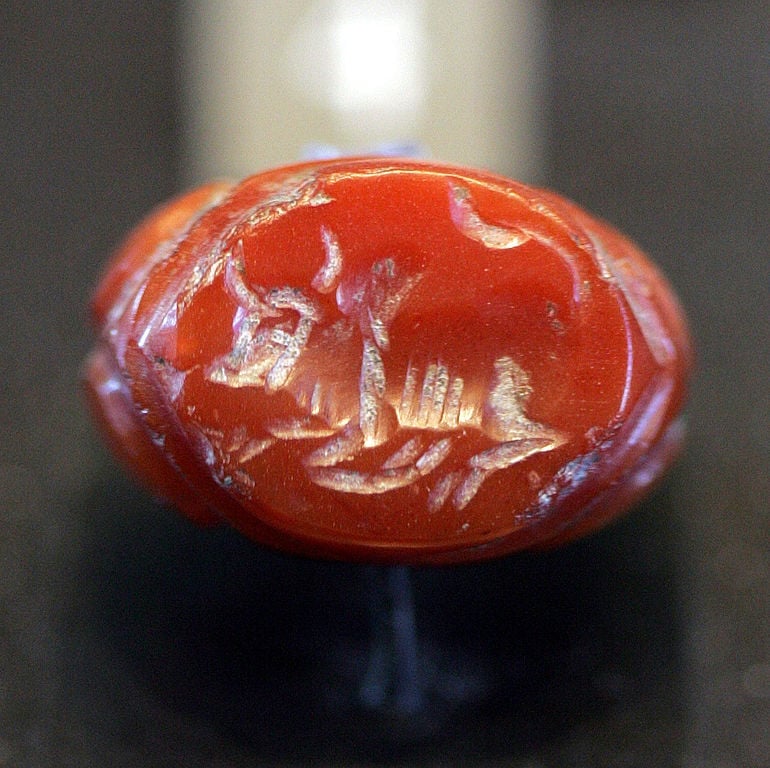Carnelian Symbolism
Carnelian symbolism and lore touches on health, luck, and royalty. However, just wearing these gems isn't always effective. Would-be alchemists and Napoleons beware.
3 Minute Read
Red for the Body, Blue for the Spirit
Like carnelian, lapis lazuli has been used for jewelry for millennia. While blue lapis became frequently associated with spirituality and priests, carnelian became associated with kings. Perhaps due to the stone's blood-like color, healers often prescribed wearing carnelian as a general invigorator for the blood. Some people wore it for problems such as nosebleeds, skin diseases, and PMS. Others carried it to stimulate sexual impulses.
In this video, Jake Talve-Goodman of The Concierge Gemologist discusses the gemological properties and traditional symbolism of carnelian and shows us some beautiful examples of this gemstone.
Carnelian Symbolism and Gem Language
Since ancient times, many people have considered the carnelian a lucky stone. Over the centuries, this belief has grown elaborately. The English and French royal courts of the 18th century used a symbolic "gem language" to convey messages discreetly. The first letters of the gems set in brooches and other jewelry pieces conveyed a motto or sentiment. Thus, with the correct acrostic placement, wearing a carnelian brooch to dinner could mean you wish everyone "Good Luck."
Arab Traditions and Carnelian Symbolism
The Arab peoples consider the carnelian one of the stones of kings. The stone's rich, warm color often links it to projective, proactive energies associated with lions and fire. Traditionally, the stone lends courage to those in need and helps with public speaking. It would certainly benefit a king to speak like a lion, boldly roaring, and with fiery passion.
The Prophet Mohammed was said to have worn a carnelian seal set in silver on the little finger of his right hand. This may help explain the appeal of carnelian in the Arab and Muslim world. Gem cutters often engrave carnelians with small prayers for luck or to turn away envy. In Egypt, people wear carnelian to ward off the Evil Eye and instill peace.
Lost in Translation: Gem Carvings
In the Middle Ages, some scholars mistakenly believed carved gems were natural wonders. In the 13th century CE work, The Book of Wings, Ragiel gives these traits to carnelians found with these inscriptions:
A man with a sword in his hand, on a carnelian, preserves the place where it may be from lightning and tempest, and guards the wearer from vices and enchantments.
Earlier magicians and alchemists wrote about the powers stones received from certain engraved designs. They often went into great detail over how to place the appropriate image on the correct stone for maximum results. Over the centuries, these practices declined, but would-be practitioners took these writings so literally some humorous translations took hold. In The Curious Lore of Precious Stones, George Kunz offers this example of a 15th century French translation boondoggle:
"If you find a dromedary (one humped camel) engraved on a stone with hair flowing over its shoulders, this stone will bring peace and concord between man and wife." The original Latin text read, "If you find Andromeda on a stone with hair flowing over her shoulders, etc."
The Perils of Wearing Gemstones You Don't Believe In
During Napoleon's Egyptian campaign (1798-1799), he acquired an octagonal, inscribed carnelian seal. Both Napoleon Bonaparte and his nephew Napoleon III held this talisman in high regard bordering on superstition. Napoleon III wore the seal on his watch chain. He gave it to his son, the Prince Imperial, Louis-Napoleon, and instructed him to wear it. However, the Prince Imperial merely followed orders while wearing this piece. Obviously, his faith in this talisman didn't run as deep as the faith the Zulus put into their weapons. When they slew him in South Africa in 1879, they took it from him.
So, be you Prince Imperial or alchemist extraordinaire, you must believe in the gems before they'll work.
Properly wearing an engraved stone like a carnelian can have very deep meaning for those inclined to study them. Carnelian symbolism certainly has a rich history. You can take it seriously or simply wish your dinner host and hostess "Good Luck" with the right jewelry.
I'll leave you with "Pledges of Blessing" a poem by Goethe from his work, West-Eastern Diwan, Book of the Singer:
Carnelian is a Talisman,
It brings good luck to child and man;
If resting on an onyx ground,
A sacred kiss imprint when found.
It drives away all evil things;
To thee and thine protection brings.
The Name of Allah, king of kings,
If graven on this stone, indeed,
will move to love and doughty deed.
From such a gem a woman gains
Sweet hope and comfort in her pains.
Fara Braid
Related Articles
Carnelian Value, Price, and Jewelry Information
Montana Burst: Faceting Design Diagram
Michael Hing’s Jubilee Project
Budgy: Faceting Design Diagram
Latest Articles
800 Years of Mogok: A Celebration in Tenuous Times
What is the Average Gemstone Faceting Yield?
Pyroxmangite Value, Price, and Jewelry Information
How to Identify Emerald Simulants and Synthetics
Never Stop Learning
When you join the IGS community, you get trusted diamond & gemstone information when you need it.
Get Gemology Insights
Get started with the International Gem Society’s free guide to gemstone identification. Join our weekly newsletter & get a free copy of the Gem ID Checklist!
